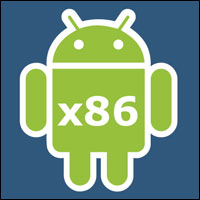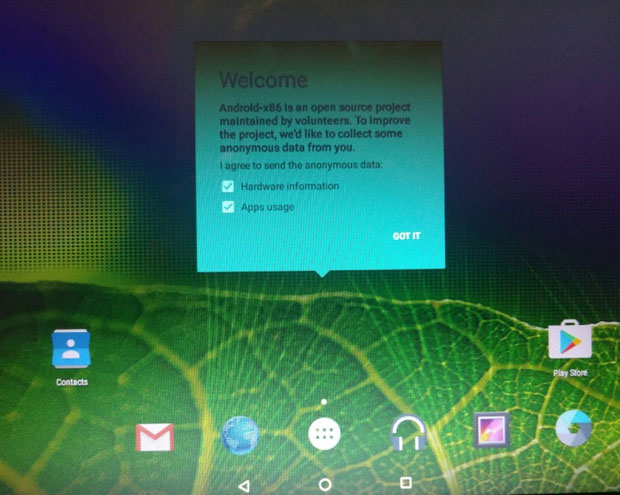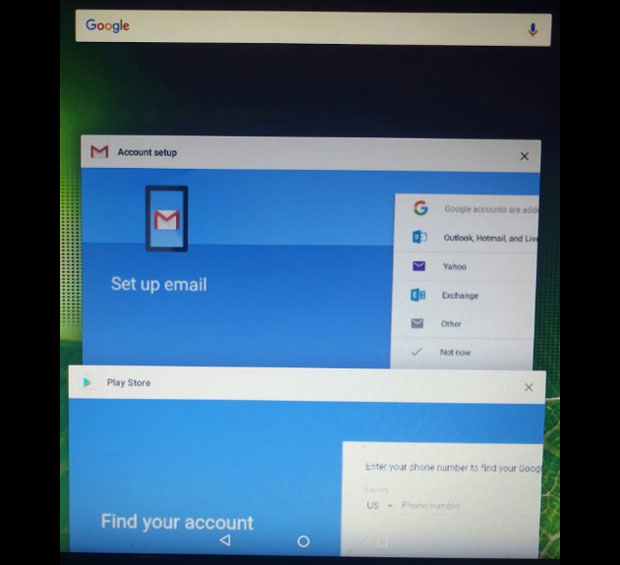
![]()
The Android-x86 Project eventually may become a viable operating system alternative for your desktop and laptops computers, but it’s not there yet. You will have to wait a while for the developers to fix a number of failures with the latest release upgrading Android-x86 to Marshmallow 6.0.1.
The developers late this summer released the first stable version of Android-x86 6.0, codenamed “Marshmallow.” Android-x86 lets you run the Android OS with the Google Chrome browser on your desktop and laptop computers, rather than buying one of the qualified Chromebooks with the Google Play Store features bolted on.

This latest release may be stable in name only, however. I had much more difficulty with it than with earlier versions. I ran into lots of trouble running this Marshmallow release on several of my test computers, which range from low-memory legacy rigs to top-of-the-line boxes.
Even worse is its crippled performance in a virtual machine. Android-x86’s sluggish performance in a VM is particularly disappointing. I had high hopes for running the Android OS on my main work desktop without having to adding yet another dual-boot option to the hard drive.
I have followed the progress of the Android-x86 project from its early stages through Android 4.0.4 (Ice Cream Sandwich) and 4.4-RC1 (KitKat-x86) to this current Marshmallow 6.0.1 release. Given the growing popularity of the Chrome OS paired with Android apps on selected Chromebook models, the Android-x86 Project could offer a productive alternative once the kinks are ironed out.
Disappointing User Experience
Android-x86 Marshmallow is slow, sluggish and locks up often. The installation routine is much clunkier than earlier releases. Some of the installation screens seem ridiculous for their intended use on PCs. For instance, one screen directs users to insert a SIM card. Multiple screens direct users to check instructions that came with the tablet for completing various setup steps.
I experienced little difference in running the live DVD or full hard drive installation. Every instance suffered the same failure when it came to the setup screen that gives an option to restore installed apps from one of my Android devices. Each attempt, on every device, resulted in a message saying restore can not be done.
The installation process was marred further when I could not advance the screens by clicking on the circled arrow that served as the “next page” input. That problem seemed connected to a larger issue involving input device incompatibility with touchscreens, mouse and keyboard navigational keys.
Much Not Working
Even when I was able to advance pages to complete the setup process, actually using the desktop posed problems with input and navigation. Those issues were not present in earlier Android-x86 versions.
Hopefully, this is a performance issue that the developers can tweak. Not being able to use the normal computer keyboard and mouse navigating controls mars the user experience. However, Android-x86 is otherwise functional on hardware that succeeds in running it.
How about using it on a touchscreen? No dice! The touchscreen on my very new HP wide screen laptop (with Windows 10 excised from it) was completely unresponsive to touchscreen input.
The touchpad was just as nonfunctional. A plug-in mouse made no difference. No mouse was detected, and no mouse pointer was displayed.
Some of the Google Android apps worked reasonably well. Those are the apps that require little in the way of input or gesture controls. I found that I could pull down menus and items that reside in the notification bar if the mouse worked — but the window slid back out of sight.
The cure was to double-click on the bar. That kept the dropdown display visible. I found similar navigational workarounds through an app-by-app trial and error process.
Desktop Environment
Using Android-x86 is very similar to running the Chrome OS on a Chromebook with the Google Play Store feature meshed into the user experience. For example, selecting a Google Now news or event card opens the display in a new tab window if the Google Chrome browser already is running. If it is not running, then Google Chrome opens with the selected item displayed.

Android-x86 has two home screens. Both show the Google search window. At the top of the screen is a translucent panel bar that does nothing but anchor on the right side a digital clock, battery status icon and WiFi indicator.
Each home screen has a Google search box for typing and a voice input icon at the top center of the screen. The home screen layout is considerably changed from previous versions of Android-x86.
Across the bottom of the Android screen are the expected Return, Home and Recent Apps buttons. Above them are the launch icons for Google Mail and Google Music Play, the apps drawer launcher button, and the image gallery and Web browser launchers. Above them are the launch icons for Contacts and the Play Store.

Using Android-x86
The first run with Android-x86 for the PC is identical to the setup process for an Android tablet or smartphone. It requires creating or signing into a Google account. The process also involves configuring the WiFi connection.
If you do not have or decline to set up a Google account, a plain vanilla Android OS desktop loads. It gives you access to the Internet through the default Android Web browser. There is no other browser option available.
Accessing the Google Play store requires Google credentials to proceed. You have basic functionality to use the preinstalled apps without registering your Google account. If you sign in to your Google account, all of your Google Chrome or other mobile Android settings populate your PC’s new OS — that is, except for the failed option to restore apps from your backup file for your other Android devices.
What’s New Inside
This release contains two files; one is the 32-bit x86 ISO image, and the other is the 64-bit x86_64 ISO image. Both can be booted from legacy BIOS and newer UEFI firmware. Improvements in the current release include an upgrade to version 4.4.20 of the Linux kernel.
One of the known issues is the display. The built-in browser messes up sometimes on the Skylake GPU. Also, suspend and resume do not work on some devices.
The ISO file shows on the first screen the choice of running in live session without installation or going directly to the installation mode.
Definitely try the live session option first. Getting to this first screen is no guarantee that the current version will run on your hardware, even it that same hardware ran earlier versions.
Bottom Line
Do not confuse the standalone Android-x86 Project with a similar commercial product, RemixOS by Jide.
Android-x86Project developer Chih-Wei Huang earlier this year announced a partnership with the Jide Company.
Jide was pursing a similar effort to have an Android OS run on PCs, as RemixOS. The partnership will accelerate both projects to achieve the goal of putting a complete Android experience on both Windows and Mac hardware, Huang said.
Jide also has a September release of the Android Marshmallow upgrade. This review is not based on the Jide release.
I took a quick peek at the RemixOS Marshmallow release for comparison. It has a much different look and feel — one that resembles a more traditional Linux desktop. You have the option to activate access to Google Play Store and integrate Android apps or use Jide’s own app store.
RemixOS runs the Google Chrome Web browser, but Chrome is just the Web browser app rather than the desktop interface.
Want to Suggest a Review?
Is there a Linux software application or distro you’d like to suggest for review? Something you love or would like to get to know?
Please email your ideas to me, and I’ll consider them for a future Linux Picks and Pans column.
And use the Reader Comments feature below to provide your input!





















































I’ve seen a few devices running Android that act like a 2 in 1 computer. But many seem to have trouble finding a market. I know from my experience with my Android tablet that Android might be OK on smartphones, its rather poor on any bigger screen. Android still not as polished as IOS as a bigger screen OS. While I still do not think Apple has created a notebook killer in IOS by any stretch. Android is even further behind IOS in making it useful.Implementing Android apps into Chrome OS seems even more strange in relationships. It’s less useful than I thought it would be.
Thank you for the article. I appreciate the honest review. I had a similar experience with trying to install Remix_OS Not primarily with functionality, with the exception of the HDMI not being able to output. Just strange things like I was installing it on a 64bit computer but was given an error stating that something was not supportetd and I needed to install the 32bit version, amongst other install errors in regard to not being able to start things I wasn’t farmiliar with. I did install the 32bit version & it seemed fairly good but decided to ditch it due to the HDMI issue. I was doing it on a repaired computer for my manager at work, as a sort of surprise because he uses Android on his tablet and phone. Figured it would be something that may run his computer more efficiently etc… as a last ditch effort to give him the functionality that i had hoped for I installed BlueStack on it. I didn’t try it due to having to log in, and he’s given me no feedback on it.
I have bought in on the Remix IO Im really hoping they do what they have stated and come up with a functional alternative to Windows 10 and put Android along with it’s Play Store bank of apps available for our living room computer. It all plays well with what I would like. We purchsed the Xtreamer Ultra years ago, and have liked it. It’s just a bit dated and struggles with windows 10 a bit.